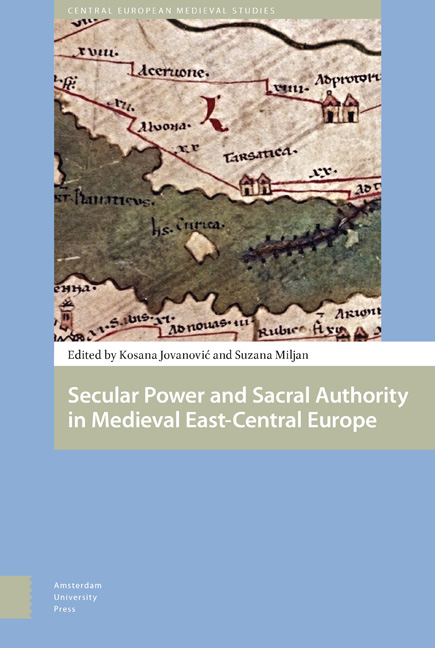Book contents
- Frontmatter
- Contents
- List of Figures and Tables
- Acknowledgements
- Foreword
- Folklore of the Medieval Kings of Hungary: Preliminary Research Report
- Variations on Nobility in Central and South-Eastern Europe: An Introduction
- The Changes of Office of Ban of Slavonia after the Mongol Invasion in Hungary (1242-1267)
- The Reconstruction and Role of Roads in the Formation of a Medieval Cultural Landscape: The Example of Episcopal Estates of Dubrava, Ivanić and Čazma
- From Castle-Warrior to Nobleman: Case Study of a Family of Slavonian Lesser Nobility
- Late Medieval Village in Turopolje (Slavonia): The Example of Donja Lomnica
- Economic Development and Transformation of the Pauline Monasteries near Senj under the Frankapan Patronage
- The Society of the Noble Judges in Northeastern Hungary during the Reign of King Sigismund (1387-1437)
- Development of Ragusan Diplomatic Service in the First Half of the Fifteenth Century: Father and Son at the Court of Duke Sandalj Hranić
- Croatian Students at the University of Prague in the Fifteenth Century
- A Contribution to Medieval Croatian Diplomatics: Cyrillic Charters of Croatian Nobility from the Franciscan Monastery on Trsat in Rijeka
- Peter of Crkvica, a Man Who Could Be Trusted: The Career of a Middle-Ranking Cleric and Diplomat in the Kingdom of Hungary in Mid-Fifteenth Century
- The Nobility of the Despotate of Serbia between Ottoman Empire and Hungary (1457-1459)
- List of Contributors
- Index
Foreword
Published online by Cambridge University Press: 12 December 2020
- Frontmatter
- Contents
- List of Figures and Tables
- Acknowledgements
- Foreword
- Folklore of the Medieval Kings of Hungary: Preliminary Research Report
- Variations on Nobility in Central and South-Eastern Europe: An Introduction
- The Changes of Office of Ban of Slavonia after the Mongol Invasion in Hungary (1242-1267)
- The Reconstruction and Role of Roads in the Formation of a Medieval Cultural Landscape: The Example of Episcopal Estates of Dubrava, Ivanić and Čazma
- From Castle-Warrior to Nobleman: Case Study of a Family of Slavonian Lesser Nobility
- Late Medieval Village in Turopolje (Slavonia): The Example of Donja Lomnica
- Economic Development and Transformation of the Pauline Monasteries near Senj under the Frankapan Patronage
- The Society of the Noble Judges in Northeastern Hungary during the Reign of King Sigismund (1387-1437)
- Development of Ragusan Diplomatic Service in the First Half of the Fifteenth Century: Father and Son at the Court of Duke Sandalj Hranić
- Croatian Students at the University of Prague in the Fifteenth Century
- A Contribution to Medieval Croatian Diplomatics: Cyrillic Charters of Croatian Nobility from the Franciscan Monastery on Trsat in Rijeka
- Peter of Crkvica, a Man Who Could Be Trusted: The Career of a Middle-Ranking Cleric and Diplomat in the Kingdom of Hungary in Mid-Fifteenth Century
- The Nobility of the Despotate of Serbia between Ottoman Empire and Hungary (1457-1459)
- List of Contributors
- Index
Summary
The present volume bears the title Secular Power and Sacral Authority in Medieval East-Central Europe. The volume encompasses a collection of papers presented at the international conference entitled Second medieval workshop in Rijeka held at the Faculty of Humanities and Social Sciences in Rijeka (Croatia) on 10th and 11th October 2014. The main goal of this volume is to enable scholars, who are at the start of their careers, to present their research on a broad spectrum of medieval themes and problems, in new methodologies, which have a strong base in tradition. It should be emphasized that a lot of work on this volume owes to a strong collaboration with the Department of Medieval Studies of the Central European University in Budapest or with the scholars who have been associated with them. Budapest is still the best forum for gathering of young and experienced scholars, and the idea of a Medieval Workshop in Rijeka is to further that bond.
Since the papers presented in this volume are dealing mostly with social elite in Hungary, Croatia, Bosnia and Serbia, we have chosen to define the area as East Central Europe, without any nineteenth- or twentieth-century connotations, as explained by Nora Berend in the recent volume on the region.
All of the articles offered in this volume have generated from the debates during the workshop, and have been submitted a year later. Here we present a selection of them, with a focus on social elites which were in the position to exercise secular or sacral power.
The social elites at the centre of all of the presented studies in this volume are the ones pertaining to various types of nobility, both of secular and sacral origin, power and authority. Nobility is a social group which left the most traces in medieval sources. In the course of the medieval period nobility experienced development, diversification and even evolution. The process can be traced in the sense of terminology and practice. Social reality was reflecting their difference according to status, origin, political power, wealth, education, mobility, etc., making nobility one of the most researched medieval social groups.
- Type
- Chapter
- Information
- Publisher: Amsterdam University PressPrint publication year: 2018



